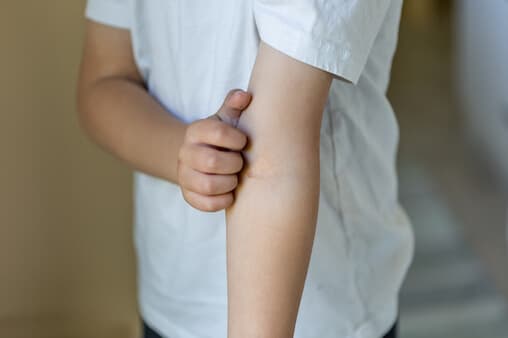How to Treat Scabies

Question
My 9 year old granddaughter has contracted scabies. What is the appropriate medication to use for this problem? It is spreading all over her body.
Wanda - Ojai, California
Dr. Greene's Answer
Scabies are tiny mites that commonly infest the skin. They are highly contagious. Children are the most vulnerable, but anyone can get them. Whenever a child develops intense itching, especially at night, the possibility of scabies should be considered.
What Are Scabies?
The adult female mite is pinpoint in size, barely visible to the unaided eye. She has four sets of legs on a round body covered with brown spines and bristles. When she lands on someone’s skin, she burrows underneath the outer layer within 30 minutes — usually without being noticed. Every day she extends her burrow by up to 1/4 inch horizontally under the surface of the skin. Along the way, she lays little oval eggs, and also leaves many tiny fecal droppings. She will survive for about a month and then die within the burrow.
The eggs hatch 3-5 days after being laid. The little larvae squirm through the burrow back towards the skin surface. They reach maturity in 2-3 weeks. They mate as soon as they find partners, and the pregnant females each start new burrows.
Scabies like to burrow in the web spaces of the fingers, the creases of the wrists, the armpits, the ankles, the feet, the genitals, and the nipples. They can occur anywhere on the body, although the face and neck are usually spared.
Do You Have Scabies?
Usually, the person doesn’t suspect any problem for about four weeks, while the mites burrow and reproduce, without causing any symptoms. Eventually, an allergic response develops in the host person. (If a healthy person has had scabies before, the allergic response begins within minutes, rather than weeks. On the other end of the time spectrum, if a new host’s immune system is suppressed, the allergic response may take months rather than weeks). Itching is caused by this normal allergic reaction to the mites, the eggs, and the feces. Itching may be quite intense and often appears before any visible sign of infestation.
Soon, 1-2 mm raised red bumps begin to appear (they often look like pimples). Sometimes they are crusted, scaling, or ulcerated. Occasionally there are blisters or hives. Threadlike burrows are sometimes visible under the skin. After several weeks or several months, though, a widespread eczema-like rash may camouflage the original problem. The scabies rash is sometimes confused with drug reactions, eczema, seborrhea, chickenpox, and other viral rashes.
Scabies Treatment
Most cases of scabies are completely eradicated with a single overnight application of 5% permethrin cream (Elimite cream), available by prescription. It is the preferred agent to treat scabies all the way down to 2 months of age (more than 30% of scabies are now resistant to Eurax lotion, an earlier treatment). Elimite should be massaged into the skin from the scalp all the way to the soles of the feet. It should be thoroughly rinsed off 8-14 hours later. All family members, baby-sitters, and close physical contacts should be treated. Usually, a 2-oz tube will treat one adult.
We’ve heard from a lot of our readers that permethrin isn’t working for them. Our friends at The People’s Pharmacy agee that scabies are developing resistance to permethrin. According to Terry Graedon, “Ivermectin is a drug used to treat a variety of parasites including heartworm and river blindness. It is fairly effective against scabies either orally or as a lotion (Rosumeck et al, Cochrane Database of Systematic Reviews, April 2, 2018) [but] the FDA has not approved ivermectin for treating scabies.”
Lindane is an effective alternative treatment, but I don’t recommend its use. It works and it is cheaper, but it is also far more toxic. In pregnant women and infants under 2 months, a smelly sulfur ointment is often used nightly for 3 to 5 days.
How Scabies Are Spread
Spread of the mites is usually directly from person to person, but the mites can live with no host for 48 to 72 hours. For this reason, clothing and bedding should be washed in hot water. When this is not possible, items should be left in a sealed plastic bag for 7 to 10 days.
Even after successful treatment, the dead mites, dead eggs, and fecal material will remain in the skin for 2 to 4 weeks (until the skin grows out). Thus, intense itching is expected to continue. Antihistamines (especially at night), topical steroid creams, and the liberal use of moisturizers will often help. Sometimes antibiotics are needed if scratching results in a bacterial infection. If the rash continues to spread after treatment, or if itching persists for longer than 2-4 weeks, reexamination and/or retreatment may be necessary.
Scabies infestations result from close physical contact, not from dirtiness or poor hygiene. Treat all contacts aggressively now, rather than waiting for the infestation to spread any further.


